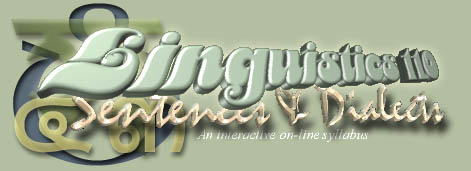
Course Management & Organization
Linguistics 110 is organized to provide students with a direct experience with the syntactic (structural) and semantic (denotative) phenomena of English and a small range of European languages during the first half of the semester. This experience, in addition to a brief introduction to the phonetic (sound) structure of language, is then applied to understanding how and why human languages differ because of social and geographical factors. The first part of the course is based less on reading than on developing analytical skills in solving problems surrounding linguistic structure and meaning and the complex relations between them.
For example, what are the structural (syntactic) differences which explain the ambiguities of such headlines as British Left Waffles on Falkland Islands or phrases like flying airplanes can be dangerous? What is the relation between the structure and meaning of that allows us to refer to civil engineer who is rude, and why doesn't a criminal lawyer have to be a lawyer who is criminal? Obviously, something interesting is going on between the structure and meaning of these phrases. The purpose of the first part of the course is to answer just these kinds of questions. Homework during the first half of the course will include written problems designed to provide a first-hand knowledge of and experience with the intricacies of linguistic structures such as these. The general procedure is to complete 4-5 sets of about 3 problems each, after they are corrected and reviewed in class, a final set is turned in to be graded.
Once a sense of the nature of linguistic structure is acquired, the course will turn its attention to why and how language varies from one geographical location to another, from one ethnic, social, and professional class to another. Do speakers of Black English not know the grammar of 'standard' English? Why do they speak differently? Why do chemists and doctor talk among themselves differently than they do with others? The segment of the course will also examine the relation between language and attitudes. Some languages have only 2 words for basic colors. Does this mean that the people speaking that language see only two basic colors? Do words like chairman, postman, workman cause speakers of English to preserve male domination in society or does it reflect that domination? Can male dominated society be overcome by making changes to the way we talk. What are the effects of ethnic jokes on individuals and communities? This portion of the course will rely on readings, lectures, videos, and discussions and requires no written homework.
The course concludes with an examination of writing systems and computational linguistics. It explores such questions as, what is the relationship between writing systems and the languages they represent? Is it possible to spell 'fish' ghoti in English as Bernard Shaw once claimed? Finally, questions of the relationship of the mind and computers will be raised as the course turns to computational syntax and semantics. Why do we want to teach computers to talk and how do we do it. The section will examine recent successes and failures in attempting to program computers to comprehend human speech in order to come to an understanding of how such research can help us understand more about ourselves.
Linguistics 110 raises the awareness of what it means to speak a language, the most complex symbolic system humans have ever devised, yet one which is mastered, unconsciously, between the ages of two and six. Language holds together all our cultural and social institutions. This course points out how the superficial differences among individual languages and dialects hide a deeper universal grammar which binds all human beings together.

